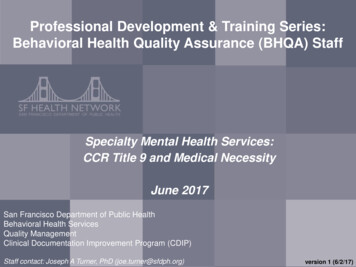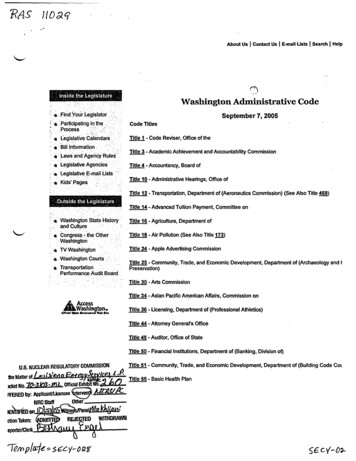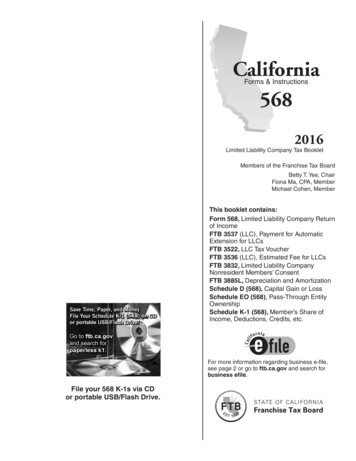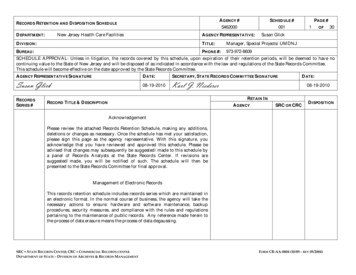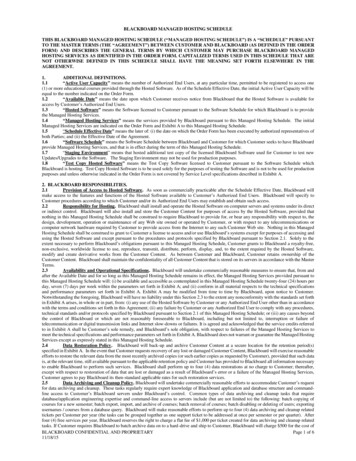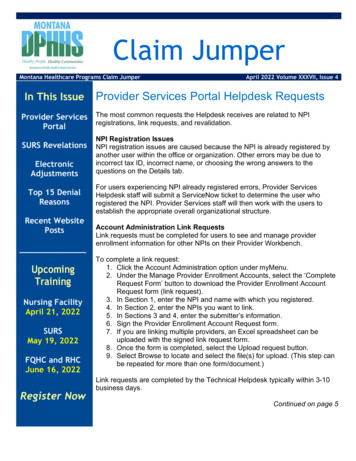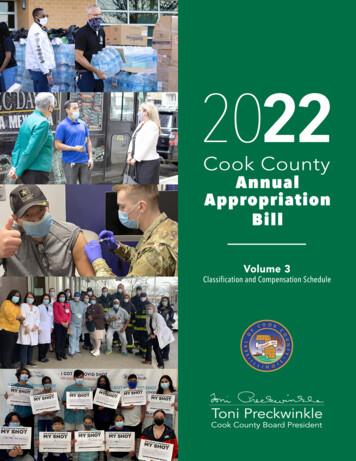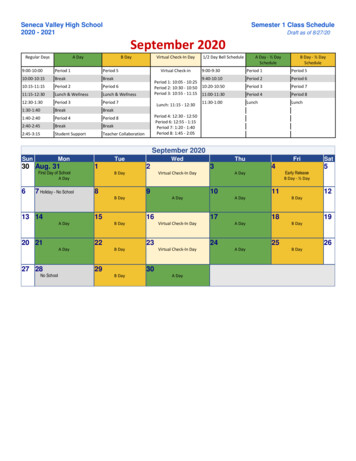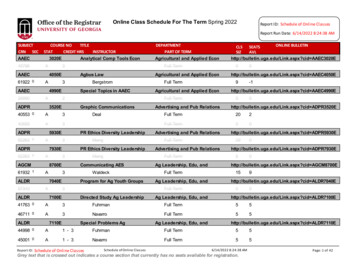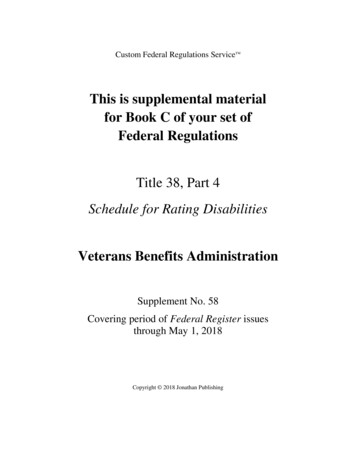
Transcription
Custom Federal Regulations Service This is supplemental materialfor Book C of your set ofFederal RegulationsTitle 38, Part 4Schedule for Rating DisabilitiesVeterans Benefits AdministrationSupplement No. 58Covering period of Federal Register issuesthrough May 1, 2018Copyright 2018 Jonathan Publishing
Need Assistance?Questions concerning MISSING SUPPLEMENTS, need for ADDITIONAL BOOKS, and otherDISTRIBUTION LIST issues for this loose-leaf service should be directed to:Department of Veterans AffairsVeterans Benefits AdministrationAdministrationMail Code: 20M33810 Vermont Avenue, N.W.Washington DC 20420Telephone: 202/273-7588Fax: 202/275-5947E-mail: coarms@vba.va.govQuestions concerning the FILING INSTRUCTIONS for this loose-leaf service,or the reporting of SUBSTANTIVE ERRORS in the text,may be directed to:Jonathan Publishing660 Laurel St, B-103Baton Rouge LA 70802Telephone: 225-205-573Fax: 702-993-6003E-mail: info@jonpub.comCopyright 2018 Jonathan PublishingC-58–2
GENERAL INSTRUCTIONSCustom Federal Regulations Service Supplemental Materials for Book CCode of Federal RegulationsTitle 38, Part 4Schedule for Rating DisabilitiesVeterans Benefits AdministrationSupplement No. 585 May 2018Covering the period of Federal Register issuesthrough May 1, 2018When Book C was originally prepared, it was current through finalregulations published in the Federal Register of 24 March 1992. These supplemental materials are designed to keep your regulations up to date. You should filethe attached pages immediately, and record the fact that you did so on theSupplement Filing Record which is at page C-8 of Book C, Schedule for RatingDisabilities.C-58–3
To ensure accuracy and timeliness of your materials,it is important that you follow these simple procedures:1. Always file your supplemental materials immediately upon receipt.2. Before filing, always check the Supplement Filing Record (page C-8)to be sure that all prior supplements have been filed. If you are missing anysupplements, contact the Veterans Benefits Administration at the address listedon page C-2.3. After filing, enter the relevant information on the Supplement FilingRecord sheet (page C-8)—the date filed, name/initials of filer, and date throughwhich the Federal Register is covered.4. If as a result of a failure to file, or an undelivered supplement, youhave more than one supplement to file at a time, be certain to file them inchronological order, lower number first.5. Always retain the filing instructions (simply insert them at the backof the book) as a backup record of filing and for reference in case of a filingerror.6. Be certain that you permanently discard any pages indicated forremoval in the filing instructions in order to avoid confusion later.To execute the filing instructions, simply remove and throw away thepages listed under Remove These Old Pages, and replace them in each case with thecorresponding pages from this supplement listed under Add These New Pages.Occasionally new pages will be added without removal of any old material(reflecting new regulations), and occasionally old pages will be removed withoutaddition of any new material (reflecting rescinded regulations)—in these cases theword None will appear in the appropriate column.C-58–4
FILING INSTRUCTIONSBook C, Supplement No. 58May 5, 2018Remove theseold pagesAdd thesenew pagesSection(s)AffectedDo not file this supplement until you confirm thatall prior supplements have been filed4.25-2 to 4.25-34.25-2 to 4.25-3§4.254.76a-2 to 4.80-14.76a-2 to 4.80-1§§4.77, 4.78, 4.794.116-1 to 4.116-44.116-1 to 4.116-4§4.116App A-1 to App A-12App A-1 to App A-12Appendix AApp B-1 to App B-22App B-1 to App B-22Appendix BApp C-1 to App C-20App C-1 to App C-20Appendix CBe sure to complete theSupplement Filing Record (page C-8)when you have finished filing this material.C-58–5
HIGHLIGHTSBook C, Supplement No. 58May 5, 2018Supplement Highlights references: Where substantive changes are made in the text ofregulations, the paragraphs of Highlights sections are cited at the end of the relevant section of text.Thus, if you are reading §3.263, you will see a note at the end of that section which reads:“Supplement Highlights references—6(2).” This means that paragraph 2 of the Highlights section inSupplement No. 6 contains information about the changes made in §3.263. By keeping and filing theHighlights sections, you will have a reference source explaining all substantive changes in the text ofthe regulations.Supplement frequency: This Book C (Schedule for Rating Disabilities) was originallysupplemented four times a year, in February, May, August, and November. Beginning 1 August1995, supplements will be issued every month during which a final rule addition or modification ismade to the parts of Title 38 covered by this book. Supplements will be numbered consecutively asissued.Modifications in this supplement include the following:1. On 9 April 2018, the VA published a final rule effective 13 May 2018, to amend theDepartment of Veterans Affairs (VA) Schedule for Rating Disabilities (VASRD) by revising theportion of the rating schedule that addresses gynecological conditions and disorders of the breast.The effect of this action is to ensure that this portion of the rating schedule uses current medicalterminology and to provide detailed and updated criteria for evaluation of gynecological conditionsand disorders of the breast. Changes: In §4.116, revised entry for diagnostic codes 7610, 7615, 7619, 7621, 7627 &7628. In §4.116, removed entries for diagnostic codes 7622 & 7623. In §4.116, added entry for diagnostic codes 7630, 7631 & 7632. Amended Appendices A, B and C to reflect these changes.C-58–6
2. On 10 April 2018, the VA published a final rule effective 13 May 2018, to revise theportion of the VA Schedule for Rating Disabilities (VASRD or rating schedule) that addresses theorgans of special sense and schedule of ratings--eye. The final rule incorporates medical advancesthat have occurred since the last review, updates current medical terminology, and provides clearerevaluation criteria. Changes: In §4.77, revised paragraph (a). In §4.78, revised paragraph (a). In §4.79, relocated diagnostic codes 6000 through 6009 and revised the sectionentitled General Rating Formula. In §4.79, revised diagnostic codes 6000, 6006, 6009-6015, 6017-6018, 60266027, 6034-6036 and 6091. In §4.79, added diagnostic codes 6040, 6042, and 6046. Amended Appendices A, B and C to reflect these changes.3. On 24 April 2018, the VA published a final rule, correcting amendment effective thatsame day, to correct a misprint which contained two typographical errors found in Table I of theCombined Ratings. Changes: In §4.25, revised row 89. C-58–7
ReservedC-58–8
4.25-24.25-2§4.25—Combined ratings No. 58 5/5/18)
4.25-34.25-3§4.25—Combined ratings tableTable I—Combined Ratings Table .99(Authority: 38 U.S.C. 1155)[41 FR 11293, Mar. 18, 1976, as amended at 54 FR 27161, June 28, 1989; 54 FR 36029, Aug.31, 1989; 83 FR 17756, Apr. 24, 2018]Supplement Highlights references: 58(3).(No. 58 5/5/18)
4.76a-2(No. 46 12/5/08)§4.76a—Computation of average concentric contraction of visual fields4.76a-2
4.77-1§4.77—Visual fields4.77-1§4.77 Visual fields.(a) Examination of visual fields. Examiners must use either Goldmann kinetic perimetryor automated perimetry using Humphrey Model 750, Octopus Model 101, or later versions ofthese perimetric devices with simulated kinetic Goldmann testing capability. For phakic (normal)individuals, as well as for pseudophakic or aphakic individuals who are well adapted tointraocular lens implant or contact lens correction, visual field examinations must be conductedusing a standard target size and luminance, which is Goldmann's equivalent III/4e. For aphakicindividuals not well adapted to contact lens correction or pseudophakic individuals not welladapted to intraocular lens implant, visual field examinations must be conducted usingGoldmann's equivalent IV/4e. The examiner must document the results for at least 16 meridians22\1/2\ degrees apart for each eye and indicate the Goldmann equivalent used. See Table III forthe normal extent (in degrees) of the visual fields at the 8 principal meridians (45 degrees apart).When the examiner indicates that additional testing is necessary to evaluate visual fields, theadditional testing must be conducted using either a tangent screen or a 30-degree threshold visualfield with the Goldmann III stimulus size. The examination report must document the results ofeither the tangent screen or of the 30-degree threshold visual field with the Goldmann IIIstimulus size.(b) Evaluation of visual fields. Determine the average concentric contraction of the visualfield of each eye by measuring the remaining visual field (in degrees) at each of eight principalmeridians 45 degrees apart, adding them, and dividing the sum by eight.(c) Combination of visual field defect and decreased visual acuity. To determine theevaluation for visual impairment when both decreased visual acuity and visual field defect arepresent in one or both eyes and are service connected, separately evaluate the visual acuity andvisual field defect (expressed as a level of visual acuity), and combine them under the provisionsof §4.25. (Authority: 38 U.S.C. 1155)Figure 2 [next page][53 FR 30262, Aug. 11, 1988, as amended at 73 FR 66549, Nov. 10, 2008; 74 FR 7648,Feb. 19, 2009; 83 FR 15320, Apr. 10, 2018]Supplement Highlights references: 46(1), 47(1), 58(2).(No. 58 5/5/18)
4.77-2(No. 58 5/5/18)§4.77—Visual fields4.77-2
4.78-1§4.78—Muscle function4.78-1§4.78 Muscle function.(a) Examination of muscle function. The examiner must use a Goldmann perimeter chartor the Tangent Screen method that identifies the four major quadrants (upward, downward, left,and right lateral) and the central field (20 degrees or less) (see Figure 2). The examiner mustdocument the results of muscle function testing by identifying the quadrant(s) and range(s) ofdegrees in which diplopia exists.(b) Evaluation of muscle function.(1) An evaluation for diplopia will be assigned to only one eye. When a claimanthas both diplopia and decreased visual acuity or visual field defect, assign a level of correctedvisual acuity for the poorer eye (or the affected eye, if disability of only one eye is serviceconnected) that is: one step poorer than it would otherwise warrant if the evaluation for diplopiaunder diagnostic code 6090 is 20/70 or 20/100; two steps poorer if the evaluation underdiagnostic code 6090 is 20/200 or 15/200; or three steps poorer if the evaluation under diagnosticcode 6090 is 5/200. This adjusted level of corrected visual acuity, however, must not exceed alevel of 5/200. Use the adjusted visual acuity for the poorer eye (or the affected eye, if disabilityof only one eye is service-connected), and the corrected visual acuity for the better eye (or visualacuity of 20/40 for the other eye, if only one eye is service-connected) to determine thepercentage evaluation for visual impairment under diagnostic codes 6065 through 6066.(2) When diplopia extends beyond more than one quadrant or range of degrees,evaluate diplopia based on the quadrant and degree range that provides the highest evaluation.(3) When diplopia exists in two separate areas of the same eye, increase theequivalent visual acuity under diagnostic code 6090 to the next poorer level of visual acuity, notto exceed 5/200. (Authority: 38 U.S.C. 1155)[29 FR 6718, May 22, 1964, as amended at 43 FR 45354, Oct. 2, 1978; 73 FR 66550,Nov. 10, 2008; 83 FR 15321, Apr. 10, 2018]Supplement Highlights references: 46(1), 58(2).(No. 58 5/5/18)
4.79-1§4.79—Schedule of ratings–eye4.79-1§4.79 Schedule of ratings—eye.Unless otherwise directed, evaluate diseases of the eye under the General Rating Formula forDiseases of the Eye.DISEASES OF THE EYERatingGENERAL RATING FORMULA FOR DISEASES OF THE EYE:Evaluate on the basis of either visual impairment due to the particular condition oron incapacitating episodes, whichever results in a higher evaluation.With documented incapacitating episodes requiring 7 or more treatment visitsfor an eye condition during the past 12 months .60With documented incapacitating episodes requiring at least 5 but less than 7treatment visits for an eye condition during the past 12 months. 40With documented incapacitating episodes requiring at least 3 but less than 5treatment visits for an eye condition during the past 12 months. 20With documented incapacitating episodes requiring at least 1 but less than 3treatment visits for an eye condition during the past 12 months. 10Note (1): For the purposes of evaluation under 38 CFR 4.79, an incapacitating episode is an eyecondition severe enough to require a clinic visit to a provider specifically for treatment purposes.Note (2): Examples of treatment may include but are not limited to: Systemicimmunosuppressants or biologic agents; intravitreal or periocular injections; laser treatments; orother surgical interventionsNote (3): For the purposes of evaluating visual impairment due to the particular condition, referto 38 CFR 4.75-4.78 and to §4.79, diagnostic codes 6061-60916000 Choroidopathy, including uveitis, iritis, cyclitis, or choroiditis.6001 Keratopathy.6002 Scleritis.6006 Retinopathy or maculopathy not otherwise specified.6007 Intraocular hemorrhage.6008 Detachment of retina.6009 Unhealed eye injury.Note: This code includes orbital trauma, as well as penetrating or non-penetrating eye injury6010 Tuberculosis of eye:Active.100Inactive: Evaluate under §4.88c or §4.89 of this part, whichever is appropriate.(No. 58 5/5/18)
4.79-2§4.79—Schedule of ratings–eye4.79-26011 Retinal scars, atrophy, or irregularities:Localized scars, atrophy, or irregularities of the retina, unilateral or bilateral, thatare centrally located and that result in an irregular, duplicated, enlarged, ordiminished image .10Alternatively, evaluate based on the General Rating Formula for Diseases of the Eye, if thiswould result in a higher evaluation.6012 Angle-closure glaucoma:Evaluate under the General Rating Formula for Diseases of the Eye.Minimum evaluation if continuous medication is required . 106013 Open-angle glaucoma:Evaluate under the General Rating Formula for Diseases of the Eye. Minimumevaluation if continuous medication is required106014 Malignant neoplasms of the eye, orbit, and adnexa (excluding skin):Malignant neoplasms of the eye, orbit, and adnexa (excluding skin) that requiretherapy that is comparable to those used for systemic malignancies, i.e.,systemic chemotherapy, X-ray therapy more extensive than to the area of the eye,or surgery more extensive than enucleation . 100Note: Continue the 100 percent rating beyond the cessation of any surgical, X-ray, antineoplasticchemotherapy, or other therapeutic procedure. Six months after discontinuance of such treatment,the appropriate disability rating will be determined by mandatory VA examination. Any changein evaluation based upon that or any subsequent examination will be subject to the provisions of§3.105(e) of this chapter. If there has been no local recurrence or metastasis, evaluate based onresidualsMalignant neoplasms of the eye, orbit, and adnexa (excluding skin) that do not require therapycomparable to that for systemic malignancies:Separately evaluate visual and nonvisual impairment, e.g., disfigurement (diagnostic code7800), and combine the evaluations6015 Benign neoplasms of the eye, orbit, and adnexa (excluding skin):Separately evaluate visual and nonvisual impairment, e.g., disfigurement (diagnostic code7800), and combine the evaluations.6016 Nystagmus, central . 106017 Trachomatous conjunctivitis:Active: Evaluate under the General Rating Formula for Diseases of the Eye,minimum rating. 30Inactive: Evaluate based on residuals, such as visual impairment and disfigurement(diagnostic code 7800).(No. 58 5/5/18)
4.79-3§4.79—Schedule of ratings–eye4.79-36018 Chronic conjunctivitis (nontrachomatous):Active: Evaluate under the General Rating Formula for Diseases of the Eye,minimum rating. 10Inactive: Evaluate based on residuals, such as visual impairment and disfigurement(diagnostic code 7800).6019 Ptosis, unilateral or bilateral:Evaluate based on visual impairment or, in the absence of visual impairment, ondisfigurement (diagnostic code 7800).6020 Ectropion:Bilateral . 20Unilateral . 106021 Entropion:Bilateral . 20Unilateral . 106022 Lagophthalmos:Bilateral . 20Unilateral . 106023 Loss of eyebrows, complete, unilateral or bilateral . 106024 Loss of eyelashes, complete, unilateral or bilateral . 106025 Disorders of the lacrimal apparatus (epiphora, dacryocystitis, etc.):Bilateral . 20Unilateral . 106026 Optic neuropathy:6027 Cataract:Preoperative: Evaluate under the General Rating Formula for Diseases of the EyePostoperative: If a replacement lens is present (pseudophakia), evaluate under the GeneralRating Formula for Diseases of the Eye. If there is no replacement lens, evaluate based onaphakia (diagnostic code 6029)6029 Aphakia or dislocation of crystalline lens:Evaluate based on visual impairment, and elevate the resulting level of visual impairment onestep.Minimum (unilateral or bilateral . 306030 Paralysis of accommodation (due to neuropathy of the Oculomotor Nerve(cranial nerve III)) .20(No. 58 5/5/18)
4.79-4§4.79—Schedule of ratings–eye4.79-46032 Loss of eyelids, partial or complete:Separately evaluate both visual impairment due to eyelid loss and nonvisual impairment, e.g.,disfigurement (diagnostic code 7800), and combine the evaluations.6034 Pterygium:Evaluate under the General Rating Formula for Diseases of the Eye, disfigurement(diagnostic code 7800), conjunctivitis (diagnostic code 6018), etc., depending on theparticular findings, and combine in accordance with §4.25.6035 Keratoconus:6036 Status post corneal transplant:Evaluate under the General Rating Formula for Diseases of the Eye. Minimum,if there is pain, photophobia, and glare sensitivity. 106037 Pinguecula:Evaluate ba
C-58-6 HIGHLIGHTS Book C, Supplement No. 58 May 5, 2018 Supplement Highlights references: Where substantive changes are made in the text of regulations, the paragraphs of Highlights sections are cited at the end of the relevant section of text. Thus, if you are reading §3.263, you will see a note at the end of that section which reads:

